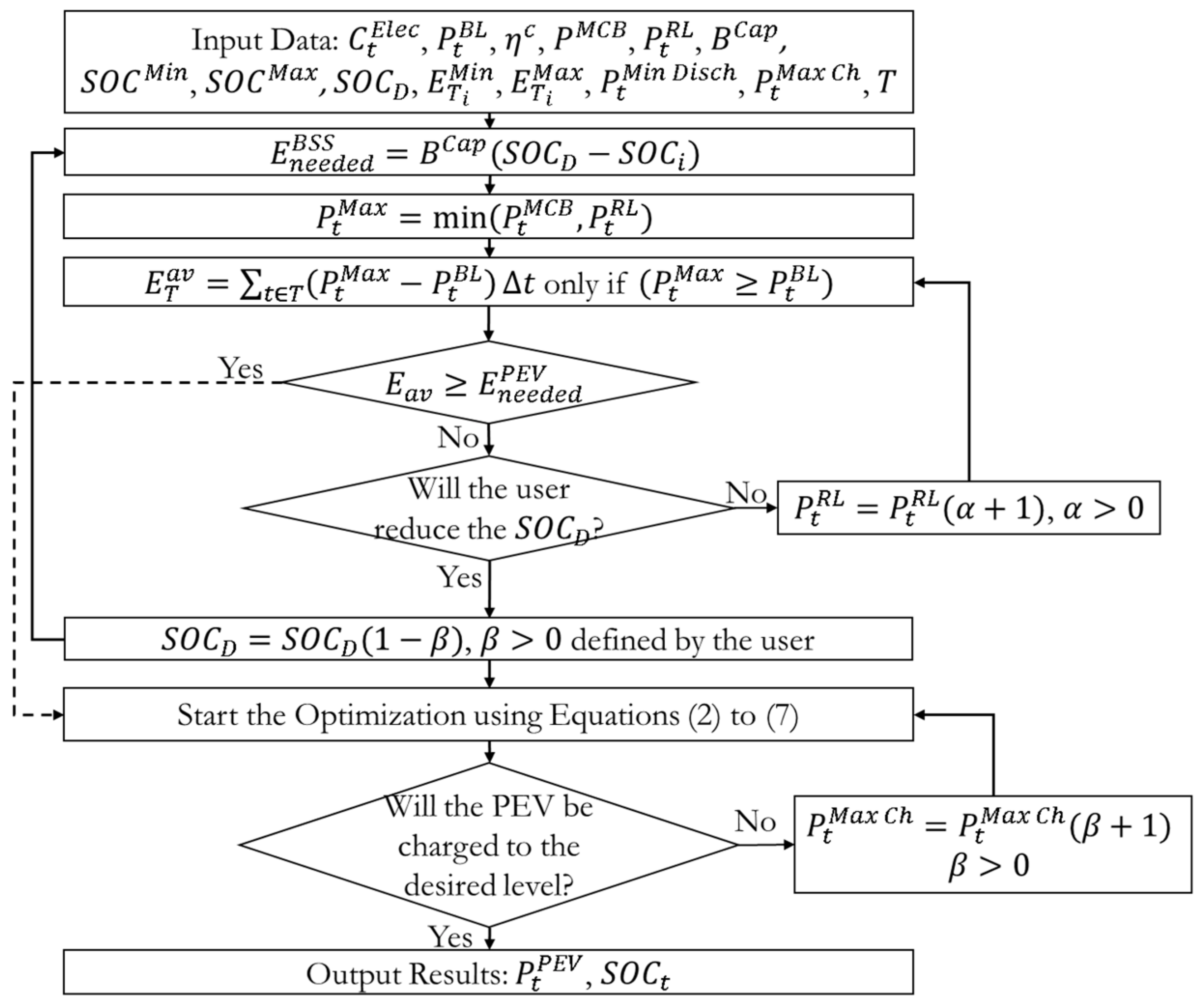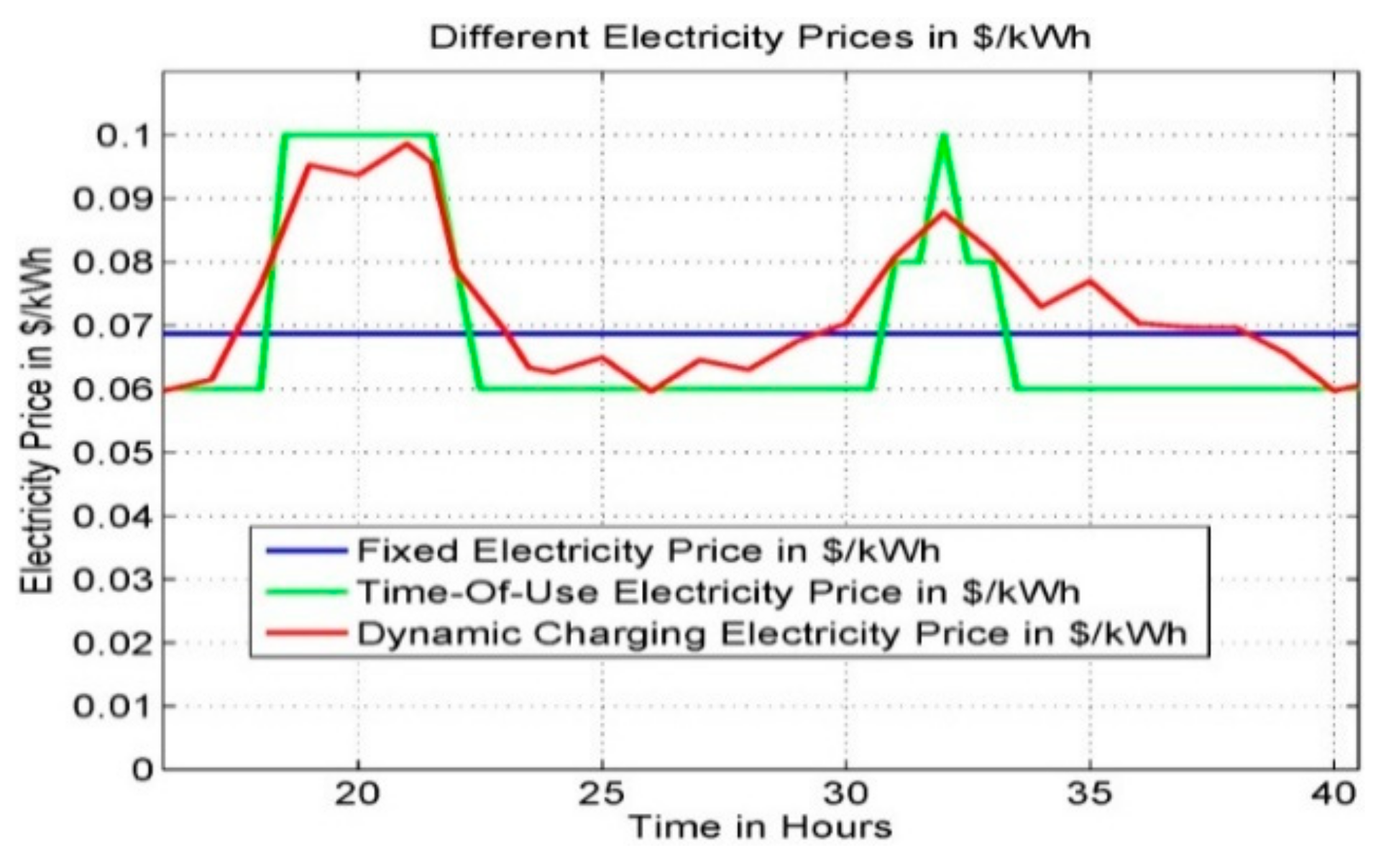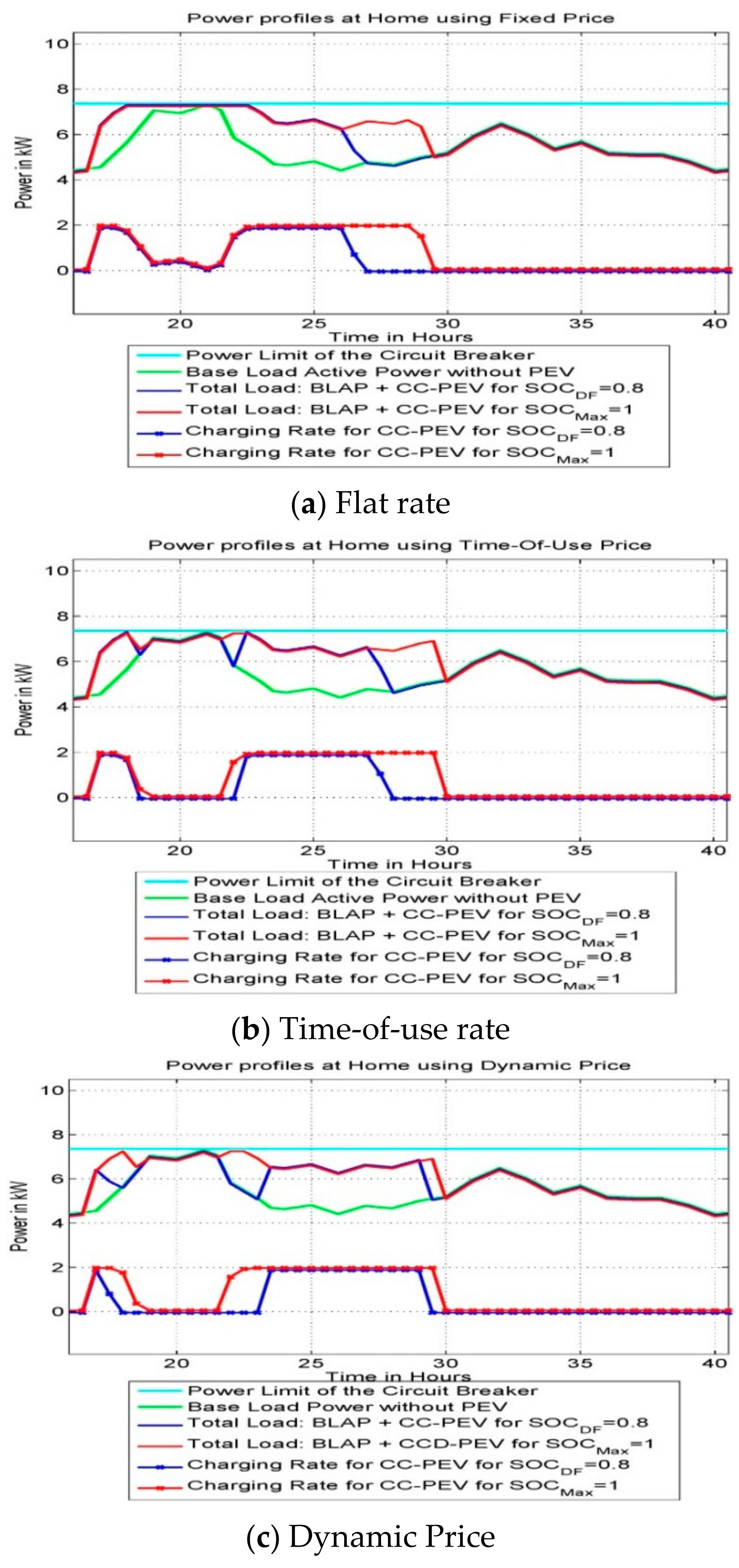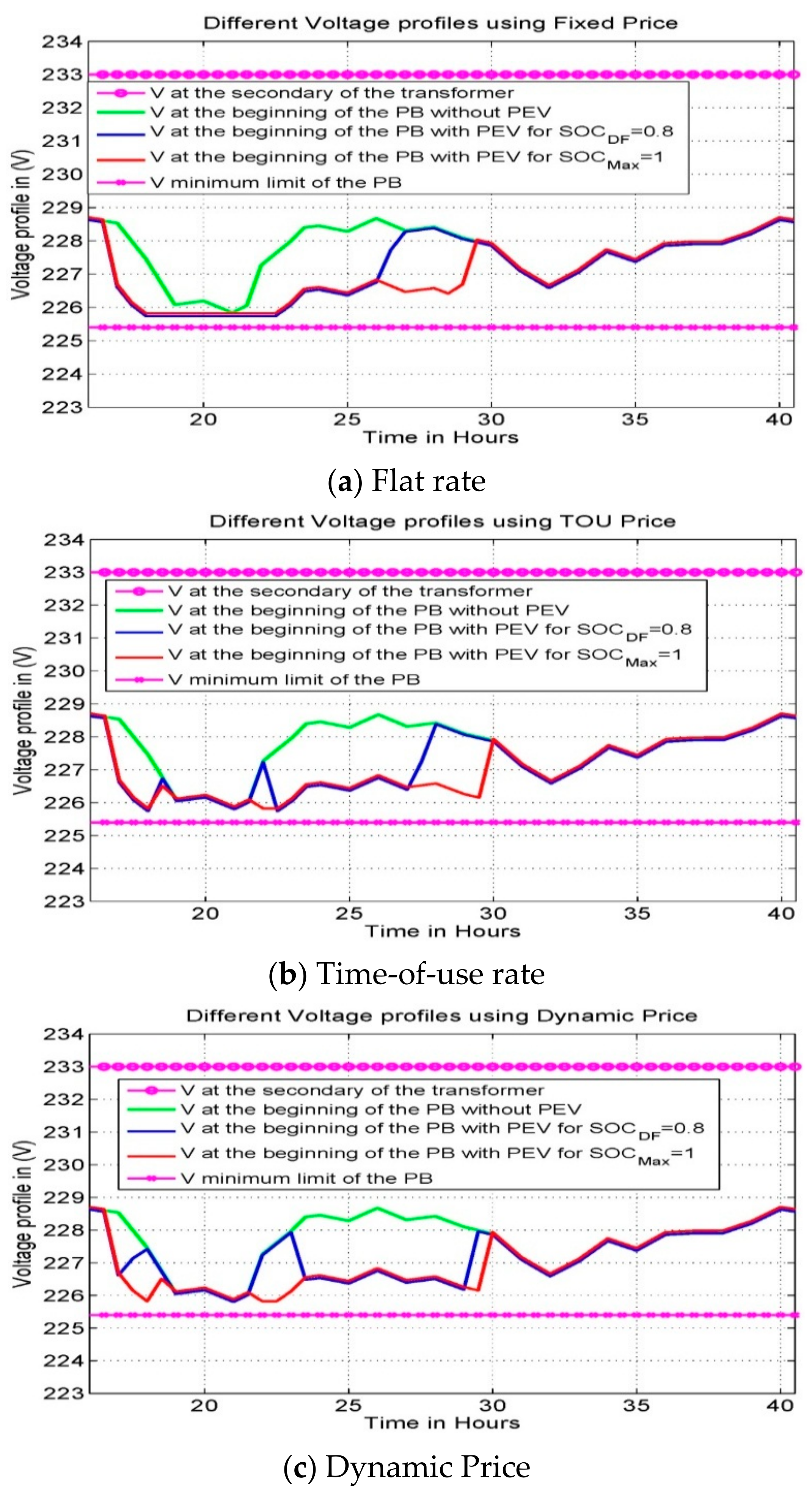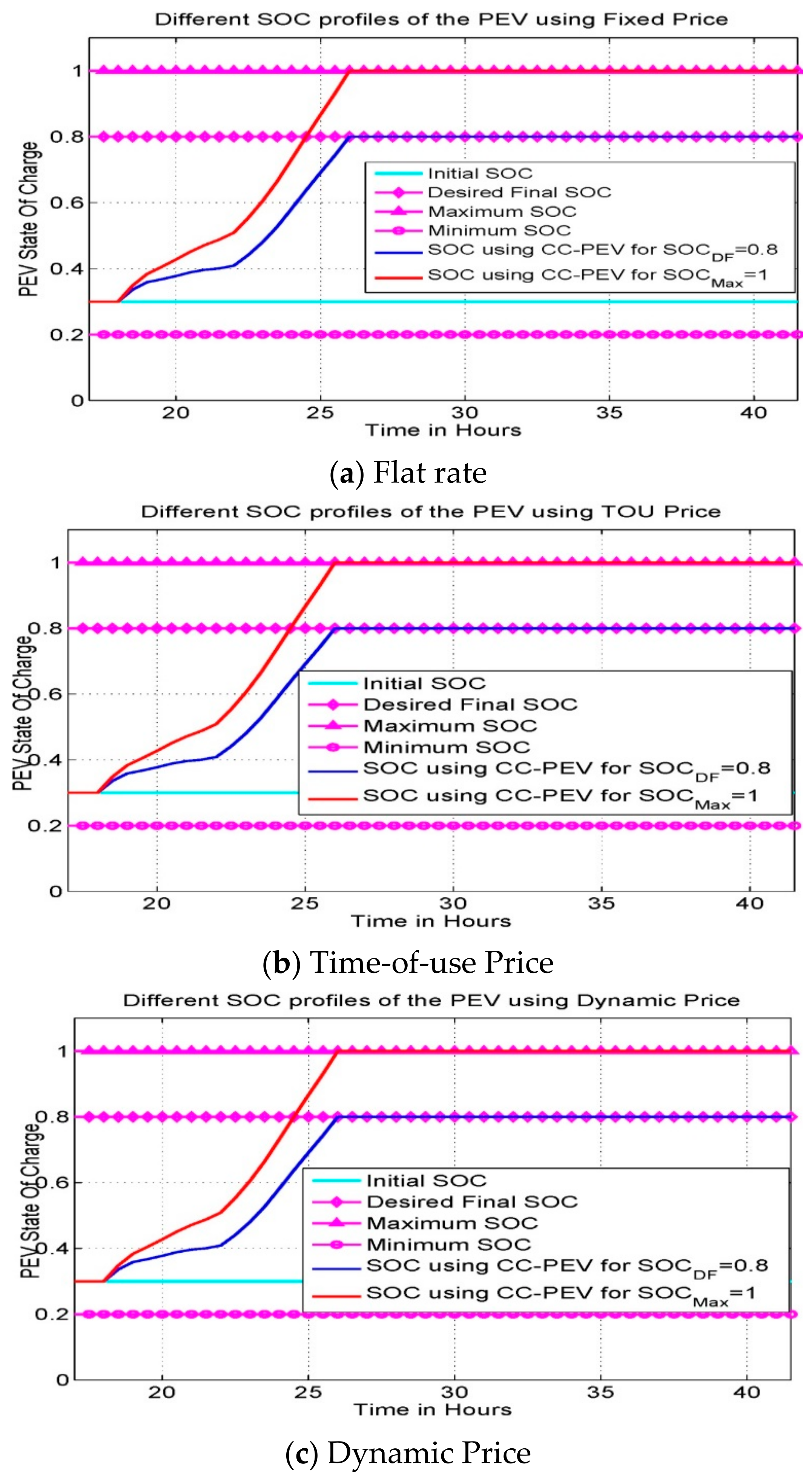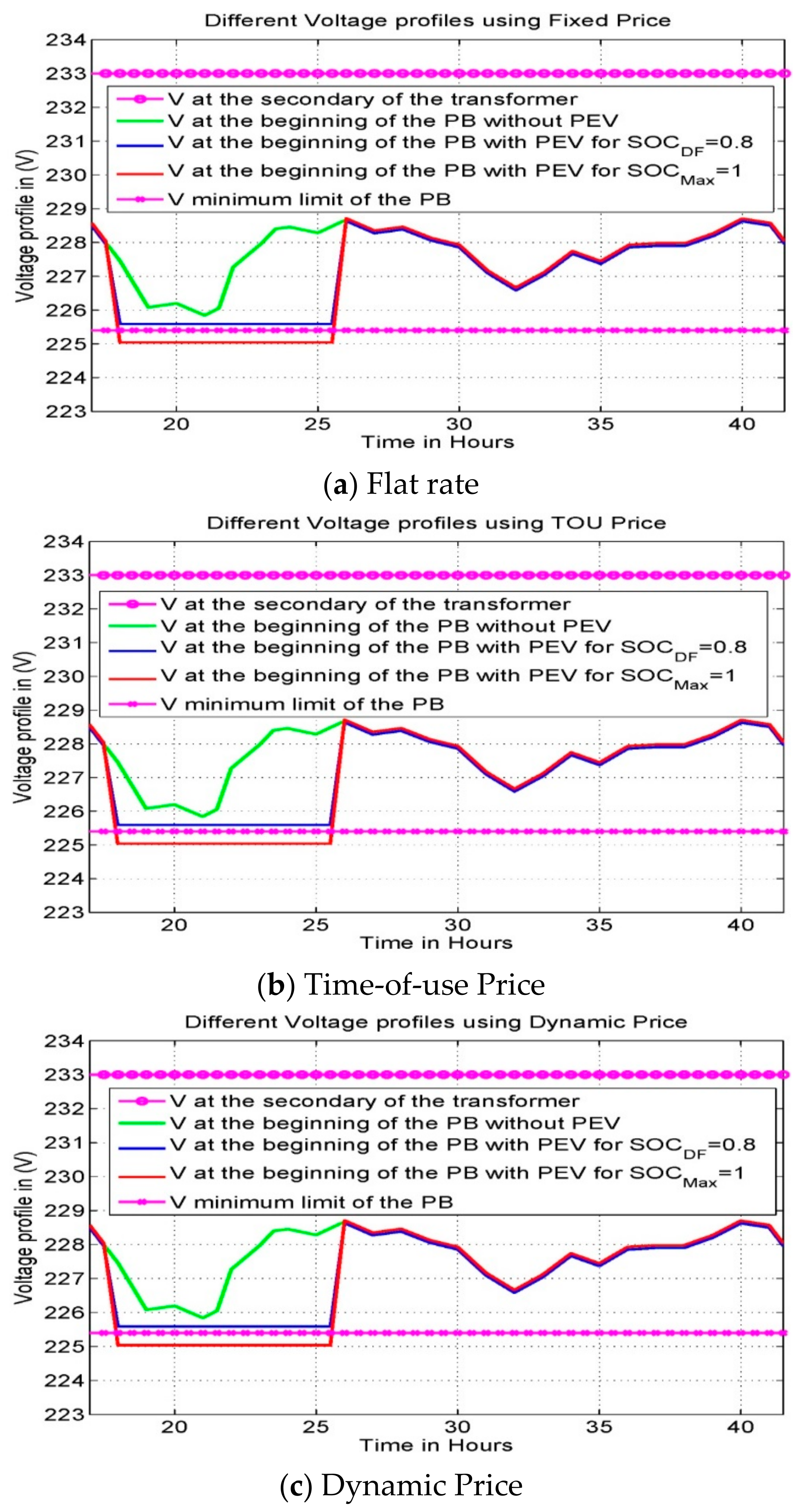3.2. Case 1: Charging Time Is Enough to Charge the PEV to the Desired State of Charge Level
In this subsection, the charging time is considered large enough to charge the PEV to the desired SOC level. Two different SOC levels are studied for the same period of time.
, and
, in which the rest of the energy (1 − 0.8 = 0.2) is charged later when the PEV arrives at the destination, on the way, or when it comes back home.
Figure 3 shows the SOC profile under three different pricing mechanisms and for two SOC levels. It can be remarked how much the electricity price affects the SOC profile during the charging process. In addition, the car owner is satisfied because the final SOC level is equal to the desired one.
Figure 4 and
Figure 5 show the profiles of the power and voltage at the home level for three cases, the baseload (BLAP), the total load with PEV and
, and the total load with PEV and
. At this point, everything seems well since the available energy at home is enough to charge the PEV. It can be remarked that the baseload power (power at home without PEV) is considered within the respected limit; the charging of PEV for
and
respects the power limit imposed by the circuit breaker. For the TOU and dynamic pricing mechanisms, and for
, the PEV is obliged to charge during high price to reach the desired SOC level which will increase the cost of charging, while for
the PEV is not charging during high prices, which will relax the charging mode and allow the algorithm to charge the PEV during low energy prices. The remaining SOC (1 − 0.8 = 0.2) will be charged later when the energy price is low.
Table 1,
Table 2 and
Table 3 represent the power quality under three different pricing mechanisms. It can be seen that the power losses and voltage drops are the least for the dynamic price compared to the TOU and fixed cost. Hence, results show how it is important to shift from the fixed cost to more sophisticated pricing mechanisms such as dynamic pricing. It can also be seen that charging the PEV to 80% instead of 100% reduced the power losses by 6.6%.
Table 4 presents the energy demand cost at home considering three distinct pricing mechanisms, (i) flat rate, (ii) time-of-use, and (iii) dynamic price. The second column shows the minimum, maximum, and total energy cost at home without PEV for each pricing mechanism. The third column represents the values of the home with PEV using coordinated charging, and the desired final SOC is
. The remaining SOC (0.2) is charged later. The fourth column shows the results for the home with PEV using coordinated charging, and the final SOC is
. From
Table 4, it is seen that when time-of-use and dynamic price are applied, and for the
, the total energy cost is improved by 0.23% and 0.61%, respectively. If the owner charges his PEV every day, the gain per year for the time-of-use price is
$0.0213 × 365 =
$7.77, and for the dynamic price it is
$0.06 × 365 =
$21.9. The improvement is small because, in both cases, the optimization technique is used to find the best solution.
3.3. Case 2: Charging Time Is Insufficient to Charge the PEV within the Initial Constraints
In this subsection, the charging time is reduced and it is not sufficient for the PEV to fully charge its battery at the same power rate. Therefore, the PEV needs a higher power rate to charge its battery, and the recommended limit of the power may not be respected. The algorithm is modeled in a way to charge the PEV to the desired SOC level with the least power rate. Two different final SOCs are studied. The first one is when the PEV is charged to a , and the second one is when the PEV is charged to a for the same period of time, but the rest of the energy (1 − 0.8 = 0.2) is charged later.
In this part, our proposed algorithm plays an important role in reducing the impact on the network and at-home levels. To calculate the available energy at home or transformer level, Equation (10) is used, which is more detailed than the one presented in the algorithm. The equation considers only the values of
, if a value of
it will not be counted in the summation. This equation is valid for both
and
.
The left side of the equation represents the available energy on the bus, transformer, or at home to charge the PEV, while the right side represents the needed energy to charge the battery to the desired SOC level. If the equation on the left side is greater or equal to the equation on the right side, it means that there is sufficient energy to charge the battery. If the battery is not charged to the desired SOC level, it means that the charging power rate should be increased. However, if the equation on the left side is smaller than the equation on the right side, it means that there is no sufficient energy to charge the battery to the desired SOC level. To solve the problem, the should be increased in a way that the total available energy should be greater or equal to the needed energy to charge the battery. If the is increased and the battery is not charged to the desired SOC level, the charging power level should be increased. Hence, our proposed algorithm can solve all these problems.
In this subsection, the charging time is considered very small in that the PEV cannot charge its battery with the same power rate. Therefore, a higher power rate is recommended to attain the desired SOC level. Two different final SOCs are studied; the first one is when the PEV is charged to a
, and the second one is when the PEV is charged to a
for the same period of time, but the rest of the energy (1 − 0.8 = 0.2) is charged later.
Figure 6 represents the curves of two different SOCs. The first one is for
, and second one is for
. It is clear that all curves for different pricing mechanisms have the same form due to the reduced period for charging. The algorithm is obliged to charge with the maximum power in order to attain the desired SOC level for difference pricing mechanisms.
In
Figure 7, the baseload (load at home without PEV) is considered within the respected limit; the charging of PEV for
and
could overpass the recommended limit because the PEV owner needs to charge his PEV to the desired SOC level, but the period for charging is small and not enough to charge the battery to the desired level with the current charging rate. Therefore, the
is increased within the period of charging, and some power rates are also increased, as mentioned before. Hence, the PEV is charging at a high price, which will increase the electricity bill. For
, the remaining SOC (1 − 0.8 = 0.2) will be charged later when the energy price is low.
In
Figure 8, the voltage profile of the baseload respects the voltage limit imposed by the standard because the cable size is chosen to maintain the voltage drop within the respected limits when the power is less or equal to the circuit breaker nominal rate. The voltage profiles for the total load for
and
may not respect the voltage limits imposed by the standards. This is due to the power, which has increased and overpassed the recommended limit in order to charge the battery to the desired SOC level during a short period of time. If the voltage drop is less but close to the recommended limit, it may not cause problems to home appliances, but a high voltage drop may cause problems at home, such as improper operation, and may damage some equipment and cause loss of energy and heating in some equipment. It can be seen that by reducing the SOC the voltage is maintained within the recommended limit, which emphasizes the importance of reducing the SOC.
Table 5,
Table 6 and
Table 7 present the power quality and losses at home. The first column represents the values of the home without PEV. The second column represents the values of the home with PEV when the desired final SOC is
. The third column represents the values of the home with PEV, when the final SOC is
. It can be observed that charging the PEV to 80% instead of 100% reduces the power losses by 9% and the voltage drop by 14.5%, which is considered a good improvement.
Table 8 presents the energy demand cost at home considering three distinct pricing mechanisms, (i) flat rate, (ii) time-of-use, (iii) and dynamic price. The second column shows the minimum, maximum, and total energy cost at home without PEV for each pricing mechanism. The third column represents the values of the home with PEV, for
. The remaining SOC (0.2) is charged later. The total cost is calculated. The fourth column shows the results of the home with PEV using coordinated charging, and the final SOC is
. From
Table 8, it can be seen that when time-of-use and dynamic price are applied, and for
, the total energy cost is improved by 0.916% and 0.81%, respectively. If the owner charges his PEV every day, the gained cost per year for the time-of-use price is (
$10.515 −
$10.4187) × 365 =
$35.15, and for the dynamic price it is (
$11.132 −
$11.042) × 365 =
$32.85. The improvement is not negligible. When the PEV needs a higher charging power rate to attain the desired SOC level, and for the TOU and dynamic prices, the PEV owner reduces the cost of charging if he charges his PEV to a SOC < 1, then the remaining energy is charged later when the energy price is low.
In this section, for the mentioned example, both studies do not respect the imposed by the circuit breaker of the home. The impact of the on the power profile is less than the , where both studies overpass the required limit, but for the limit is overpassed by a very small value. In both cases, the circuit breaker is tripped, but the case will be different for a bus, in which the transformer may not trip for , but it may trip for because the limit is overpassed by a large value. For the voltage profile, the may not pass the limit imposed by the standards, while for the , the limit may pass the standards. For the case of a transformer, overloading could increase the temperature of the transformer, thus decreasing its lifetime. Therefore, it is recommended to respect the limits imposed by the transformer’s limits and find other factors that will help the PEV to charge the battery to the desired SOC level without negatively affecting the circuit breaker and the transformer or other components on the network and home.
